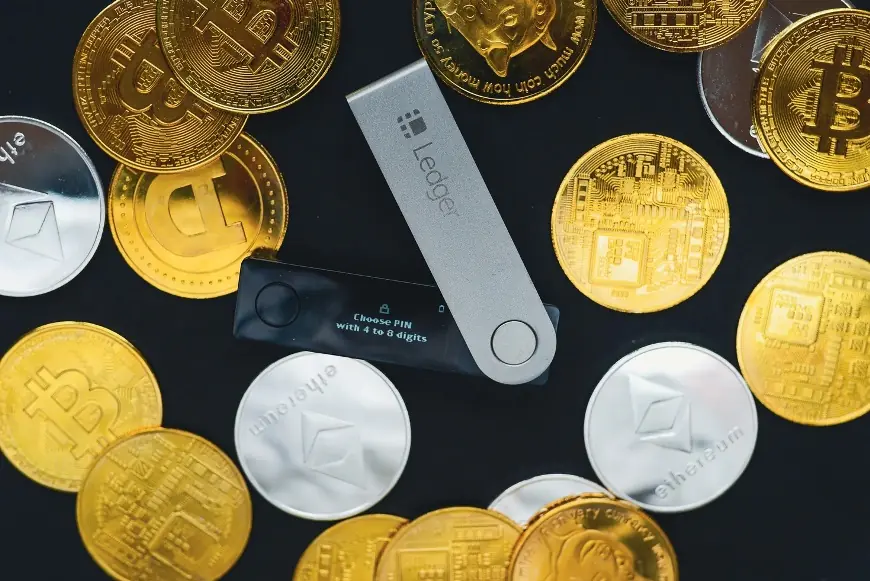

Understanding Custodial vs. Non-Custodial Crypto Wallets: Which is Right for You?
Introduction
In the ever-evolving landscape of cryptocurrencies, one of the fundamental aspects every investor or user must understand is the type of wallet they choose to store their digital assets. Crypto wallets are crucial for managing and securing cryptocurrencies, acting as the bridge between users and the blockchain. However, not all wallets are created equal. The distinction between custodial and non-custodial wallets is a pivotal one, impacting the level of control, security, and responsibility an individual holds over their digital assets.
Custodial wallets, often provided by exchanges and third-party services, offer a user-friendly experience, making them popular among newcomers to the crypto space. These wallets take on the responsibility of managing private keys, providing features like customer support, backup options, and enhanced user interfaces. However, this convenience comes at the cost of relinquishing full control over one’s assets, as the third-party provider holds the private keys.
On the other hand, non-custodial wallets empower users by giving them complete control over their private keys and funds. This type of wallet is favored by those who prioritize security and privacy, as it eliminates the risks associated with third-party custodians. Non-custodial wallets require users to take full responsibility for the security and backup of their private keys, which can be daunting for beginners but is seen as a critical aspect of true ownership in the crypto world.
Understanding the differences between these two types of wallets is essential for anyone involved in cryptocurrencies, whether they are trading, investing, or simply holding digital assets. This blog post delves into the intricacies of custodial and non-custodial wallets, exploring their advantages, disadvantages, and ideal use cases to help you make an informed decision about which wallet type best suits your needs.
What Are Crypto Wallets?
Crypto wallets are essential tools in the digital currency ecosystem, serving as the primary means for users to store, manage, and interact with their cryptocurrencies. At their core, crypto wallets are software or hardware solutions that store the private and public keys required to access and manage a user’s cryptocurrency holdings. These keys are crucial for the execution of transactions on the blockchain, where cryptocurrencies operate.
A public key functions similarly to an email address. It can be shared with others to receive cryptocurrency. On the other hand, a private key is akin to a password and must be kept secure and confidential. The private key provides the cryptographic proof needed to authorize and sign transactions, giving the user access to their digital funds.
There are various types of crypto wallets, each catering to different needs and preferences. Software wallets, which include mobile apps, desktop applications, and web-based wallets, offer convenience and accessibility. Hardware wallets, physical devices designed to store keys offline, provide enhanced security against hacking and online threats. Paper wallets, another form of offline storage, involve printing the keys on a physical medium.
Crypto wallets also differ in their operational design. Hot wallets are connected to the internet and offer quick access to funds, making them ideal for active trading and everyday transactions. Cold wallets, which are offline, prioritize security and are best suited for long-term storage of significant assets.
Understanding how crypto wallets function is crucial for anyone involved in the cryptocurrency space. They not only secure digital assets but also facilitate various activities such as trading, investing, and interacting with decentralized applications. By grasping the fundamentals of crypto wallets, users can make informed decisions about managing their digital wealth effectively and securely.
Custodial Wallets
Definition of Custodial Wallets
Custodial wallets are digital wallets where a third-party service provider, often a cryptocurrency exchange or financial institution, holds and manages the private keys on behalf of the user. This arrangement means users do not have direct control over their private keys, instead entrusting the management and security of their assets to the custodian.
How Custodial Wallets Work
When you create a custodial wallet, you are essentially creating an account with a service provider. The provider generates and stores your private keys on their servers, allowing them to manage your cryptocurrency transactions. You interact with your funds through the provider’s platform, which handles the technical details of key management, transaction signing, and security measures.
Examples of Custodial Wallet Providers
Some well-known examples of custodial wallet providers include:
- Coinbase: A popular exchange known for its user-friendly interface and strong security measures.
- Binance: One of the largest cryptocurrency exchanges globally, offering a wide range of services, including custodial wallet options.
- Kraken: Another major exchange providing custodial wallets along with advanced trading features and robust security protocols.
Pros
- User-Friendly for Beginners: Custodial wallets are designed with ease of use in mind, making them ideal for those new to cryptocurrency. The interfaces are typically intuitive, reducing the learning curve associated with managing digital assets.
- Backup and Recovery Options: Since the service provider manages the private keys, they also handle backup and recovery processes. If you lose access to your account, the provider can assist in recovering your funds.
- Customer Support Available: Many custodial wallet providers offer customer support to help users navigate issues, answer questions, and resolve problems, providing an additional layer of assistance and security.
Cons
- Lack of Full Control Over Private Keys: One of the main drawbacks of custodial wallets is that users do not have direct control over their private keys. This means you are relying on the provider to safeguard your assets.
- Potential Security Risks from Hacks: Custodial wallet providers are prime targets for hackers. If the service provider’s security is breached, your funds could be at risk. High-profile exchange hacks in the past have resulted in significant losses for users.
- Dependency on Third-Party Providers: Using a custodial wallet means placing trust in a third-party provider. If the provider experiences technical issues, regulatory problems, or goes out of business, you could lose access to your funds or face significant delays in transactions.
In summary, custodial wallets offer a balance of convenience and risk. They are well-suited for beginners and those who value ease of use and integrated services. However, it’s crucial to understand the implications of entrusting a third party with your digital assets and to carefully consider the security measures and reputation of the custodial wallet provider.
Non-Custodial Wallets
Definition of Non-Custodial Wallets
Non-custodial wallets are digital wallets where users retain full control over their private keys and, consequently, their funds. Unlike custodial wallets, no third party holds or manages the private keys on behalf of the user, granting complete ownership and responsibility to the wallet holder.
How Non-Custodial Wallets Work
When you create a non-custodial wallet, the wallet generates a pair of cryptographic keys (a public key and a private key) that are stored locally on your device. The private key is never shared with or stored by a third party. Transactions are signed directly by the user, ensuring that only the wallet owner has access to and control over their digital assets. Users must securely manage their private keys, as losing the private key means losing access to the funds.
Examples of Non-Custodial Wallet Providers
Several popular non-custodial wallet providers offer different features to cater to various user needs:
- MetaMask: A widely used browser extension wallet that supports Ethereum and ERC-20 tokens. It allows users to interact with decentralized applications (dApps) directly from their browser.
- Ledger: A hardware wallet that provides a high level of security by storing private keys offline. It supports a wide range of cryptocurrencies and is known for its robust security features.
- Trust Wallet: A mobile wallet that supports multiple cryptocurrencies and offers an intuitive interface for managing assets while ensuring users maintain control over their private keys.
Pros
- Full Control Over Private Keys and Funds: Non-custodial wallets give users complete control over their private keys and funds, ensuring that only the wallet owner can access their digital assets.
- Enhanced Privacy and Security: Since private keys are not shared with third parties, non-custodial wallets offer enhanced privacy and security. Users are protected from the risks associated with centralized custodians, such as hacking and regulatory issues.
- Independence from Third-Party Providers: Non-custodial wallets operate independently of third-party providers, reducing the risk of dependency on external entities. This independence ensures that users have continuous access to their funds regardless of external circumstances.
Cons
- Higher Responsibility for Security and Backups: Users of non-custodial wallets are solely responsible for the security and backup of their private keys. This responsibility includes safeguarding against theft, loss, and hardware failure. Failure to properly manage private keys can result in the permanent loss of funds.
- More Complex for Beginners: Non-custodial wallets can be more complex for beginners to set up and use. The requirement to manage private keys and understand the technical aspects of wallet security can be daunting for new users.
- Lack of Customer Support: Non-custodial wallets typically do not offer customer support services. Users must rely on community resources, documentation, and their own knowledge to troubleshoot and resolve any issues they encounter.
In conclusion, non-custodial wallets provide a high level of control, privacy, and security, making them ideal for users who prioritize these aspects. However, they also require a greater degree of responsibility and technical understanding. For those willing to take on the responsibility of managing their private keys, non-custodial wallets offer a robust solution for securing digital assets.
Key Differences Between Custodial and Non-Custodial Wallets
Control Over Private Keys
One of the most significant differences between custodial and non-custodial wallets is the control over private keys. Custodial wallets entrust the management of private keys to a third-party service provider, such as an exchange or financial institution. This means that users rely on the provider to secure their keys and, consequently, their funds. In contrast, non-custodial wallets give users complete control over their private keys. This autonomy ensures that only the wallet owner can access and manage their digital assets, providing a greater sense of ownership and security.
Security and Risk Considerations
Security is a critical factor in choosing between custodial and non-custodial wallets. Custodial wallets often employ sophisticated security measures, such as multi-signature authentication, encryption, and regular audits, to protect users’ funds. However, they are also attractive targets for hackers, as breaches can result in substantial losses. High-profile hacks of custodial services underscore this vulnerability.
Non-custodial wallets, on the other hand, significantly reduce the risk of centralized hacking because the private keys are stored locally with the user. However, this increased security comes with the responsibility of safeguarding the keys. Users must implement their own security practices, such as using hardware wallets, keeping backups in secure locations, and employing strong passwords.
User Experience and Accessibility
Custodial wallets are designed to be user-friendly, making them ideal for beginners and those who prefer convenience. These wallets often feature intuitive interfaces, seamless integration with trading platforms, and additional services like customer support, staking, and lending. The ease of use and comprehensive services provided by custodial wallets make them accessible to a broader audience.
In contrast, non-custodial wallets can be more complex and require a greater understanding of cryptocurrency management. Setting up and using a non-custodial wallet involves generating and securely storing private keys, which can be daunting for newcomers. However, for those who prioritize control and security, the initial learning curve is a worthwhile investment.
Backup and Recovery Processes
Backup and recovery options differ significantly between custodial and non-custodial wallets. Custodial wallets offer built-in backup and recovery services, allowing users to recover their accounts through customer support or automated recovery processes if they lose access to their accounts. This feature provides peace of mind for users who might misplace their credentials.
Non-custodial wallets require users to take full responsibility for backup and recovery. This usually involves securely storing seed phrases or private keys in multiple safe locations. If a user loses their private key or seed phrase, they permanently lose access to their funds, highlighting the importance of meticulous key management.
In summary, the key differences between custodial and non-custodial wallets revolve around control, security, user experience, and backup processes. Custodial wallets offer convenience and ease of use but come with inherent risks related to third-party control and potential security breaches. Non-custodial wallets provide enhanced security and control but require users to take full responsibility for managing and securing their private keys. Understanding these differences is essential for making an informed decision about which type of wallet best suits your needs and preferences.
Use Cases and Scenarios
Ideal Scenarios for Using Custodial Wallets
Custodial wallets are particularly well-suited for certain types of users and situations, offering convenience and ease of use that can be beneficial in various scenarios:
-
Beginners: Newcomers to the world of cryptocurrencies often find custodial wallets to be the most user-friendly option. These wallets typically feature simple interfaces and provide additional support services, such as customer assistance and educational resources, which can help beginners navigate the complexities of managing digital assets.
-
Frequent Traders: For users who engage in frequent trading, custodial wallets provided by cryptocurrency exchanges offer seamless integration with trading platforms. This allows for quick and easy transactions without the need to transfer funds between different wallets. The convenience of having funds readily available on the exchange can save time and reduce transaction fees.
-
Users Seeking Convenience: Those who prioritize convenience over control may prefer custodial wallets. With features like automated backups, recovery options, and customer support, custodial wallets reduce the burden of managing private keys and other technical aspects of cryptocurrency ownership.
-
Small to Moderate Holdings: Users with smaller amounts of cryptocurrency who are not overly concerned about maximum security might find custodial wallets sufficient for their needs. The ease of use and additional services provided can outweigh the risks associated with third-party control for these users.
Ideal Scenarios for Using Non-Custodial Wallets
Non-custodial wallets are better suited for users who prioritize control, privacy, and security. They are ideal in scenarios where these factors are paramount:
-
Privacy-Focused Users: For individuals who place a high value on privacy and want to ensure their financial activities remain confidential, non-custodial wallets are the preferred choice. Since users retain full control over their private keys, their transactions are not subject to third-party oversight, enhancing privacy.
-
Long-Term Holders (HODLers): Investors who plan to hold their cryptocurrencies for an extended period, often referred to as HODLers, benefit from the enhanced security of non-custodial wallets. By keeping their private keys offline or in highly secure environments, they minimize the risk of hacking and other security threats.
-
Large Holdings: Users with significant amounts of cryptocurrency are more likely to prioritize security over convenience. Non-custodial wallets, especially hardware wallets, provide robust security features that protect substantial holdings from potential threats.
-
Tech-Savvy Users: Individuals who are comfortable with technology and have a good understanding of cryptocurrency management often prefer non-custodial wallets. These users are capable of managing their private keys securely and appreciate the autonomy and security that non-custodial wallets offer.
-
Decentralized Finance (DeFi) Participants: Users engaged in DeFi activities often require non-custodial wallets to interact with various decentralized applications (dApps). Non-custodial wallets provide the necessary infrastructure to participate in DeFi ecosystems without relying on centralized intermediaries.
In summary, the choice between custodial and non-custodial wallets depends largely on the user’s priorities and level of experience. Custodial wallets are ideal for those seeking convenience, ease of use, and support, making them suitable for beginners and frequent traders. Non-custodial wallets, on the other hand, are best for users who prioritize security, privacy, and control, including privacy-focused users, long-term holders, and those with significant cryptocurrency investments. Understanding the specific use cases and scenarios for each type of wallet can help users make informed decisions about how to manage their digital assets effectively.
Security Tips for Both Wallet Types
Best Practices for Securing Custodial Wallets
Custodial wallets, while user-friendly and convenient, require vigilance to ensure that your funds remain secure. Here are some best practices for securing custodial wallets:
-
Choose Reputable Providers: Select custodial wallet providers with strong reputations for security. Research their security measures, past incidents, and user reviews. Reputable exchanges like Coinbase, Binance, and Kraken are generally more reliable.
-
Enable Two-Factor Authentication (2FA): Always enable 2FA for an added layer of security. This requires you to enter a secondary code, typically generated by an app like Google Authenticator, in addition to your password.
-
Use Strong, Unique Passwords: Create a strong, unique password for your custodial wallet account. Avoid using the same password across multiple sites. Use a combination of letters, numbers, and special characters.
-
Monitor Account Activity: Regularly check your account activity for any unauthorized transactions or changes. Most custodial wallets provide alerts or notifications for unusual activity.
-
Beware of Phishing Scams: Be cautious of phishing attempts. Always verify the URL before entering your login credentials and be wary of unsolicited communications asking for personal information.
-
Utilize Withdrawal Whitelists: If the custodial wallet offers a whitelist feature for withdrawal addresses, use it. This ensures that funds can only be withdrawn to pre-approved addresses.
-
Keep Software Updated: Ensure that your wallet provider’s app or website, as well as your device’s operating system, are always up-to-date to protect against security vulnerabilities.
Best Practices for Securing Non-Custodial Wallets
Non-custodial wallets provide greater control over your funds but require a higher level of personal responsibility for security. Here are some best practices for securing non-custodial wallets:
-
Securely Store Private Keys: Your private key or seed phrase is your access to your funds. Store it offline in multiple secure locations, such as a safe or safety deposit box. Never share your private key with anyone.
-
Use Hardware Wallets for Large Holdings: For significant amounts of cryptocurrency, consider using hardware wallets like Ledger or Trezor. These devices store your private keys offline, protecting them from online threats.
-
Enable Passphrases and PINs: Many non-custodial wallets offer additional security features like passphrases and PINs. Enable these to add extra layers of security to your wallet.
-
Backup Your Wallet: Regularly backup your wallet’s private key or seed phrase. Ensure that backups are stored securely and are accessible in case your primary device is lost or damaged.
-
Keep Wallet Software Updated: Ensure that your wallet software is always updated to the latest version to protect against any known vulnerabilities or exploits.
-
Use Secure Devices: Access your non-custodial wallet from secure devices. Avoid using public or shared computers, and ensure your device has up-to-date antivirus and anti-malware software.
-
Be Cautious with Browser Extensions and Apps: When using non-custodial wallets like MetaMask, be cautious with browser extensions and mobile apps. Only install extensions and apps from trusted sources, and be wary of permissions they request.
-
Avoid Storing Large Amounts on Mobile Wallets: While mobile wallets are convenient for everyday transactions, avoid storing large amounts of cryptocurrency on them. Use more secure options like hardware wallets for significant holdings.
-
Practice Good Operational Security (OpSec): Be discreet about your cryptocurrency holdings. Avoid discussing your assets and wallet details publicly or with untrusted individuals.
By following these best practices, you can significantly enhance the security of both custodial and non-custodial wallets, protecting your digital assets from potential threats. Whether you choose a custodial or non-custodial wallet, staying informed and vigilant is key to maintaining the security of your cryptocurrency.
Subscribe for More Crypto-Related Content
Stay informed and up-to-date with the latest trends, tips, and insights in the cryptocurrency world by subscribing to our blog. We regularly publish content on a wide range of topics, including wallet security, investment strategies, blockchain technology, and market analysis. By subscribing, you’ll ensure that you never miss an update and continue to enhance your understanding and management of digital assets.



